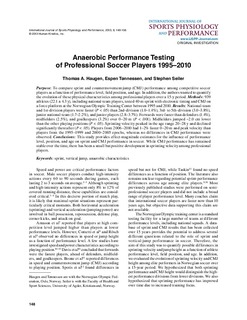| dc.contributor.author | Haugen, Thomas A | |
| dc.contributor.author | Tønnessen, Espen | |
| dc.contributor.author | Seiler, Stephen | |
| dc.date.accessioned | 2013-07-17T13:17:58Z | |
| dc.date.available | 2013-07-17T13:17:58Z | |
| dc.date.issued | 2013 | |
| dc.identifier.citation | Haugen, T.A., Tonnessen, E., & Seiler, S. (2013). Anaerobic performance testing of professional soccer players 1995-2010. International Journal of Sports Physiology and Performance, 8(2), 148-156. | no_NO |
| dc.identifier.uri | http://hdl.handle.net/11250/139059 | |
| dc.description | Published version of an article from the journal: International Journal of Sports Physiology and Performance. Also available from Human Kinetics:http://journals.humankinetics.com/ijspp-back-issues/ijspp-volume-8-issue-2-march/anaerobic-performance-testing-of-professional-soccer-players-1995ndash2010 | no_NO |
| dc.description.abstract | Purpose: To compare sprint and countermovement-jump (CMJ) performance among competitive soccer players as a function of performance level, field position, and age. In addition, the authors wanted to quantify the evolution of these physical characteristics among professional players over a 15-y period. Methods: 939 athletes (22.1 +/- 4.3 y), including national-team players, tested 40-m sprint with electronic timing and CMJ on a force platform at the Norwegian Olympic Training Center between 1995 and 2010. Results: National-team and 1st-division players were faster (P<.05) than 2nd-division (1.0-1.4%), 3rd- to 5th-division (3.0-3.8%), junior national-team (1.7-2.2%), and junior players (2.8-3.7%). Forwards were faster than defenders (1.4%), midfielders (2.5%), and goalkeepers (3.2%) over 0-20 m (P<.001). Midfielders jumped similar to 2.0 cm lower than the other playing positions (P<.05). Sprinting velocity peaked in the age range 20-28 y and declined significantly thereafter (P<.05). Players from 2006-2010 had 1-2% faster 0-20 m and peak velocity than players from the 1995-1999 and 2000-2005 epochs, whereas no differences in CMJ performance were observed. Conclusions: This study provides effect-magnitude estimates for the influence of performance level, position, and age on sprint and CMJ performance in soccer. While CMJ performance has remained stable over the time, there has been a small but positive development in sprinting velocity among professional players. | no_NO |
| dc.language.iso | eng | no_NO |
| dc.publisher | Human Kinetics | no_NO |
| dc.title | Anaerobic performance testing of professional soccer players 1995-2010 | no_NO |
| dc.type | Journal article | no_NO |
| dc.type | Peer reviewed | no_NO |
| dc.subject.nsi | VDP::Medical disciplines: 700::Sports medicine: 850 | no_NO |
| dc.source.pagenumber | 148-156 | no_NO |
| dc.source.volume | 8 | no_NO |
| dc.source.journal | International Journal of Sports Physiology and Performance (IJSPP) | no_NO |
| dc.source.issue | 2 | no_NO |
